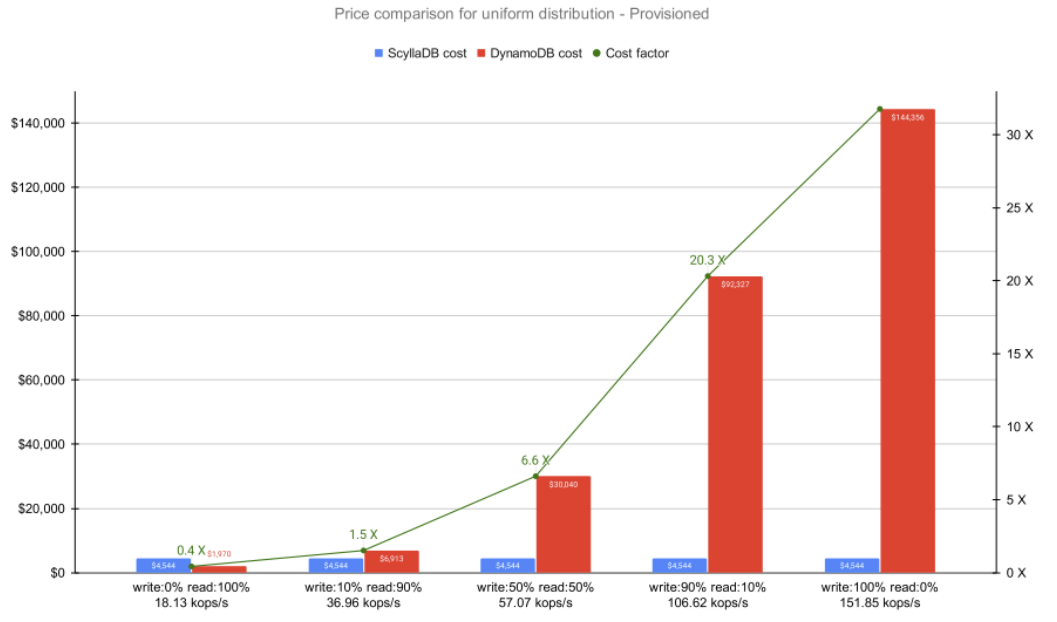5X to 40X Lower DynamoDB Costs— with Better P99 Latency
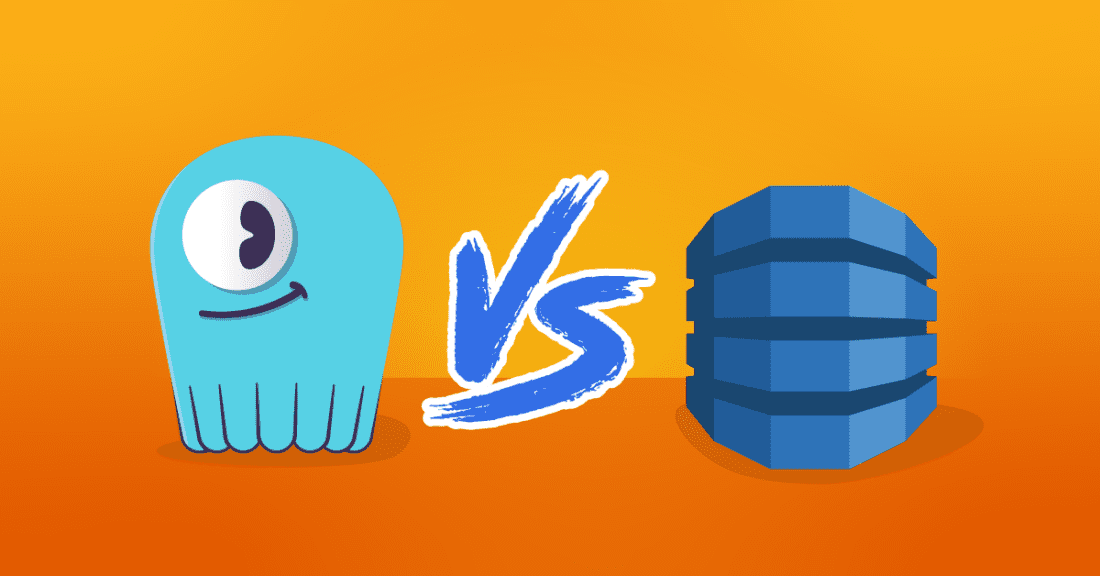
At our recent events, I’ve been fielding a lot of questions about DynamoDB costs. So, I wanted to highlight the cost comparison aspect of a recent benchmark comparing ScyllaDB and DynamoDB. This involved a detailed price-performance comparison analyzing:
- How cost compares across both DynamoDB pricing models under various workload conditions
- How latency compares across this set of workloads
I’ll share details below, but here’s a quick summary: ScyllaDB costs are significantly lower in all but one scenario. In realistic workloads, costs would be 5X to 40X lower — with up to 4X better P99 latency. Here’s a consolidated look at how DynamoDB and ScyllaDB compare on a Uniform distribution (DynamoDB’s sweet spot).
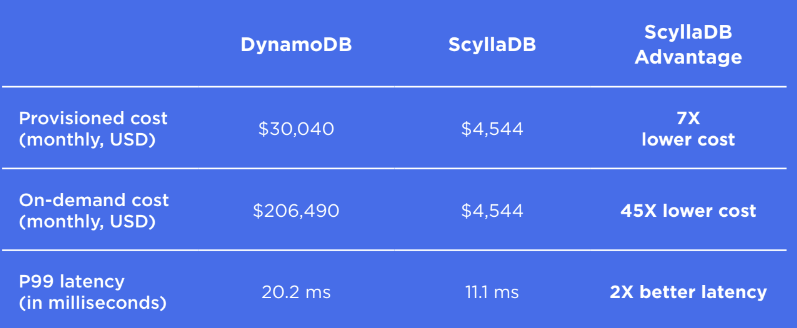
Now, more details on the cost aspect of this comparison. For a deeper dive into the performance aspect, see this DynamoDB vs ScyllaDB price-performance comparison blog as well as the complete benchmark report.
How We Compared DynamoDB Costs vs ScyllaDB Costs
For our cost comparisons, we launched a small 3-node cluster in ScyllaDB Cloud and measured performance on a wide range of workload scenarios. Next, we calculated the cost of running the same workloads on DynamoDB.
We used an item size of 1081 bytes, which translates to 2 WCUs per write operation and 1 RCU per read operation on DynamoDB. Our working data set size was 1 TB, with an approximate cost of ~$250/month in DynamoDB.
We used the same ScyllaDB cluster through every testing scenario, thus simplifying ScyllaDB Cloud costs. Hourly rates (on-demand) were used. As ScyllaDB linearly scales with the amount of resources, you can predictably adjust costs to match your desired performance outcome. Annual pricing provides significant cost reduction but is out of the scope of this benchmark.
DynamoDB has two modes for non-annual pricing: provisioned and on-demand pricing. Provisioned mode is recommended if your workloads are reasonably predictable. On-demand pricing is significantly more expensive and is a fit for unpredictable, low-throughput workloads. It is possible to combine modes, add auto-scaling, and so forth. DynamoDB provides considerable flexibility around managing the cost and scale of the aforementioned options, but this also results in considerable complexity.
For details on how we calculated costs, refer to the Cost Calculations section at the end of this article.
Throughout all tests, we ensured ScyllaDB had spare capacity at all times by keeping its load below 75%. Given that, note that it is possible to achieve higher traffic than the numbers reported here at no additional cost, in turn allowing for additional growth.
The number of operations per second that the ScyllaDB cluster performs for each workload is reported under the X axis in the following graphs.
Provisioned Cost Comparison: DynamoDB vs ScyllaDB
Provisioned mode is recommended if your workloads are reasonably predictable. With DynamoDB, you need to be able to predict per-table capacity following AWS DynamoDB read/write capacity unit pricing model.
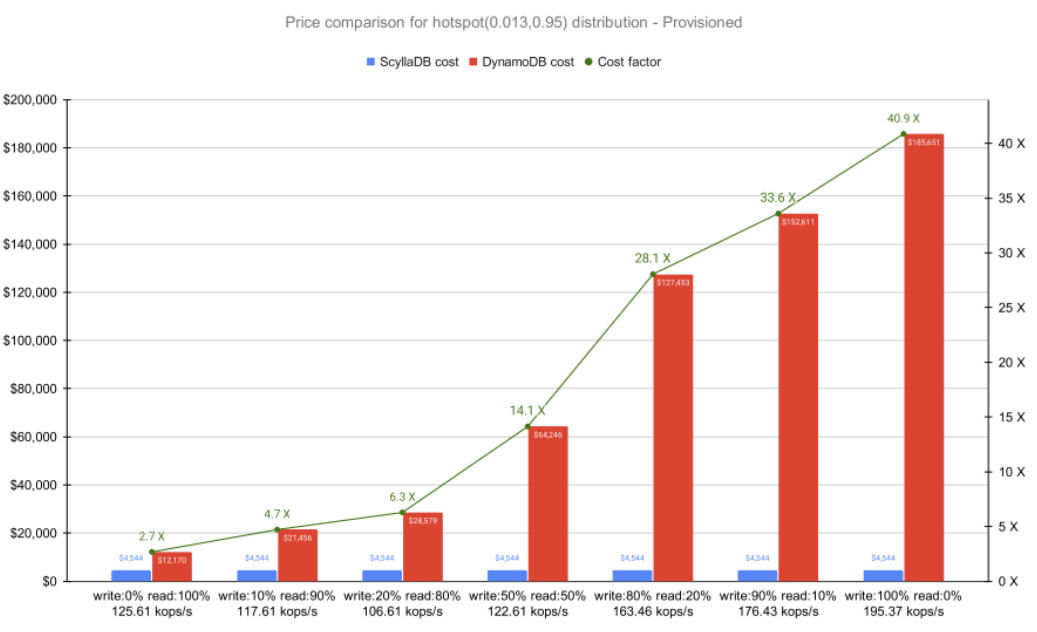
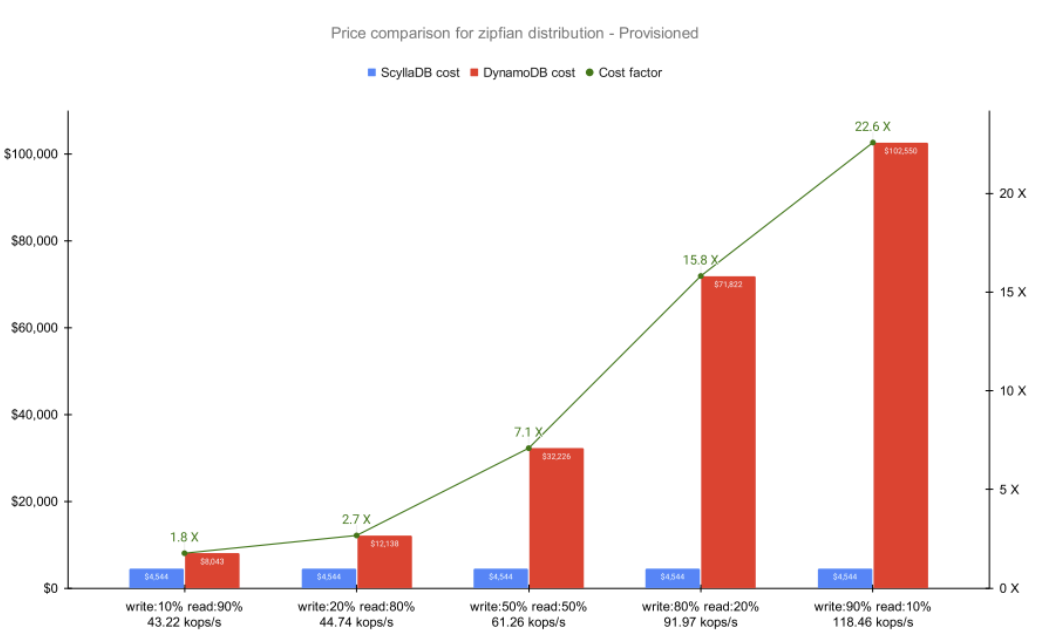
With just one exception, DynamoDB’s cost estimates were consistently higher than ScyllaDB – and much more so for the most write-heavy workloads.
In the 1 out of 15 cases where DynamoDB turned out to be less expensive, ScyllaDB could actually drive more utilization to win over DynamoDB. However, we wanted to keep the results consistent and fair.
This is not surprising, given that DynamoDB charges 5X more for writes than for reads, while ScyllaDB does not differentiate between operations, and its pricing is based on the actual cluster size.
On-Demand Cost Comparison: DynamoDB vs ScyllaDB
On-demand pricing is best when the application’s workload is unclear, the application’s data traffic patterns are unknown, and/or your company prefers a pay-as-you-go option. However, as the results show, the convenience and flexibility of DynamoDB’s on-demand pricing often come at quite a cost. To see how we calculated costs, refer to the Cost Calculations section at the end of this article.
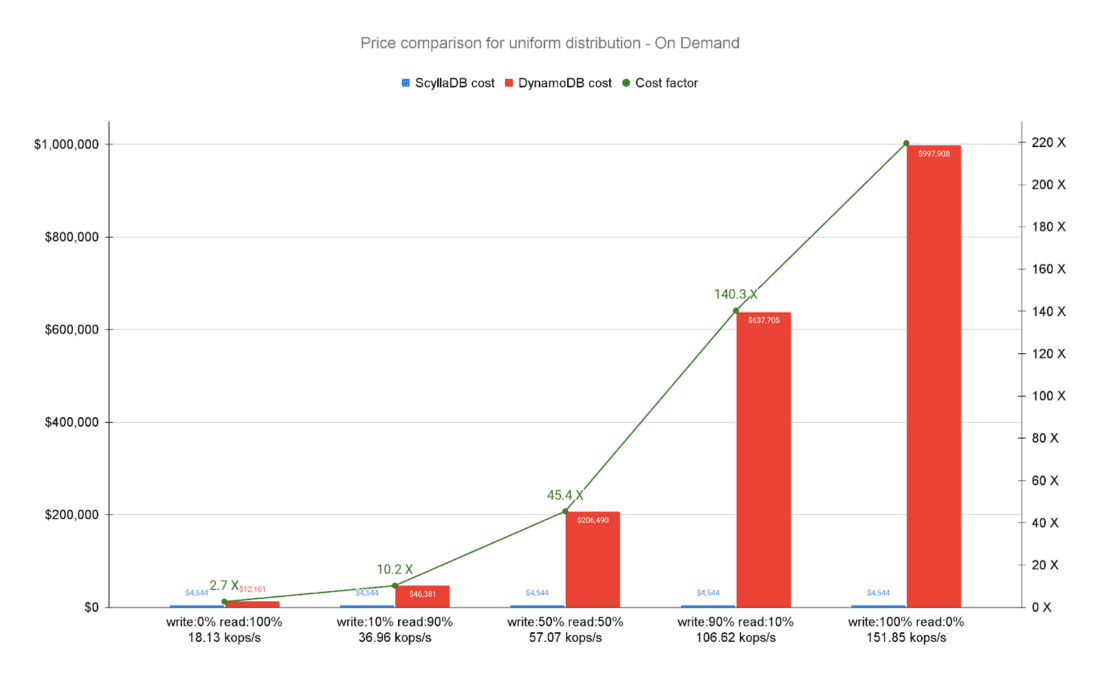
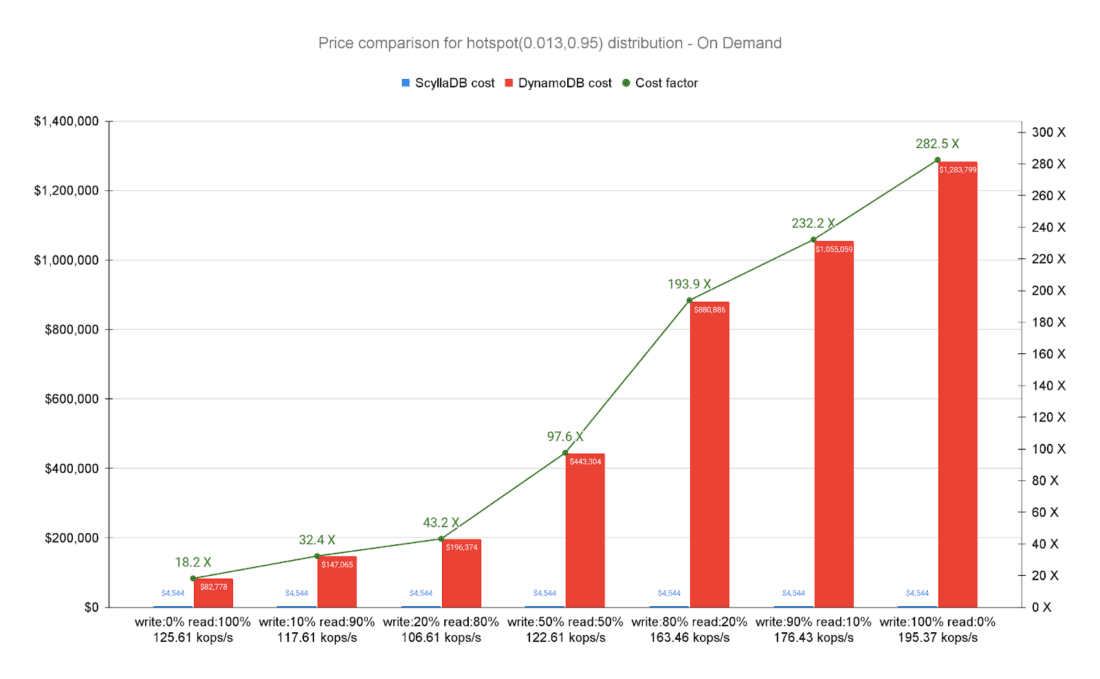
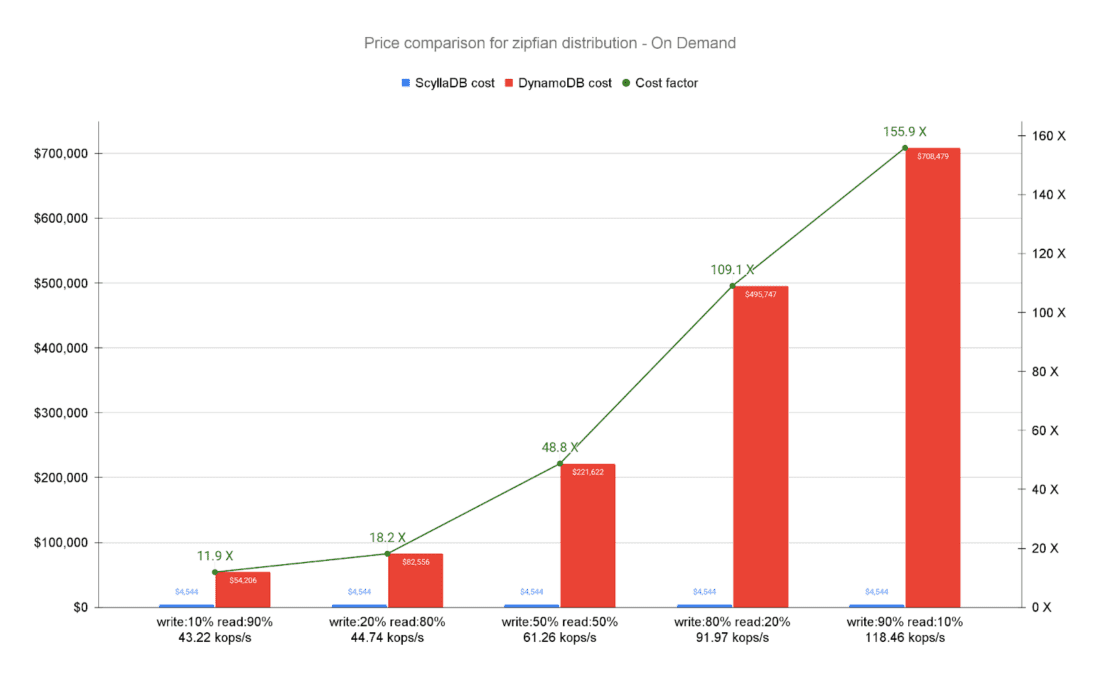
Here, the same general trends hold true. ScyllaDB cost is fixed across the board, and its cost advantage grows as write throughput increases.
ScyllaDB’s cost advantage over on-demand DynamoDB tables is significantly greater when compared to provisioned capacity on DynamoDB. Why? Because DynamoDB’s on-demand pricing is significantly higher than its provisioned capacity counterpart. Therefore, workloads with unpredictable traffic spikes (which would justify not using provisioned capacity) may easily end up with runaway bills compared to costs with ScyllaDB Cloud.
Making ScyllaDB Even More Cost Effective
Unlike DynamoDB (where you provision tables), ScyllaDB is provisioned as a cluster, capable of hosting several tables – and therefore consolidating several workloads under a single deployment. Excess hardware capacity may be shared to power more use cases on that cluster. ScyllaDB Cloud and Enterprise users can also use ScyllaDB’s Workload Prioritization to prioritize specific access patterns and further drive consolidation.
For example, assume there are 10 use cases that require 100K OPS each. With DynamoDB, users would be forced to allocate a provisioned workload per table or to use the rather expensive on-demand mode. This introduces a set of caveats: If every workload consistently reaches its peak capacity, it will likely get throttled by AWS (provisioned mode), or result in runaway bills (on-demand mode). Likewise, the opposite also holds true: If most workloads are consistently idle, provisioned mode results in non-consumed capacity bills. On-demand mode doesn’t guarantee immediate capacity to support traffic surges. This, in turn, causes your applications to experience some degree of throttling.
A standard ScyllaDB deployment is not only more cost effective, but also simplifies management. It allows users to consolidate all workloads within a single cluster and share idle capacity among them. With ScyllaDB Cloud and Enterprise, users further have the flexibility to define priorities on a per-workload basis, allowing the database to make more informed decisions when two or more workloads compete against each other for resources.
Cost Calculation Details
Here’s how we calculated costs across the different databases and pricing models.
DynamoDB Cost Calculations
Provisioned Costs for DynamoDB
With DynamoDB’s provisioned capacity mode, planning is required. You specify the number of reads and writes per second that you expect your application to require. You can make use of auto-scaling to automatically adjust your table’s capacity based on a specific utilization target in order to sustain spikes outside of your projected planning.
In provisioned mode, you need to provision DynamoDB with the expected throughput. You set WCUs (Write Capacity Units) and RCUs (Read Capacity Units) which signify the allowed number of write and read operations per second, respectively. They are priced per hour.
- One WCU is $0.00065 per hour
- One RCU is $0.00013 per hour
This yields the following formulas for calculating monthly costs:
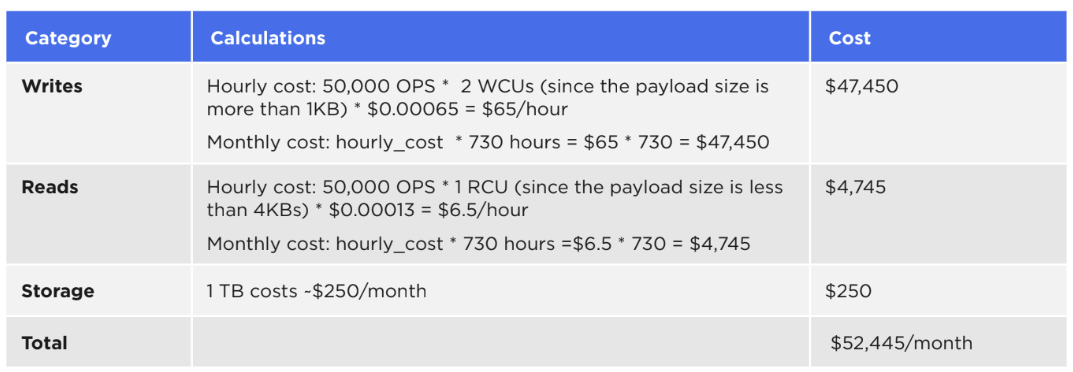
On-Demand Costs for DynamoDB
With DynamoDB’s on-demand mode, no planning is required. You pay for the actual reads/writes that your application is using (the total number of actual writes or reads, not writes or reads per second).
In this mode, you pay by usage and the cost is per request unit (rather than per capacity unit, as in the provisioned mode). AWS charges $1.25 per million write request units (WRU) and $0.25 per million read request units (RRU). Therefore, a single request unit costs 1 millionth of the actual write/read operation, as follows:
- One WRU is $0.00000125 per write
- One RRU is $0.00000025 per read
This yields the following formulas for calculating monthly costs:
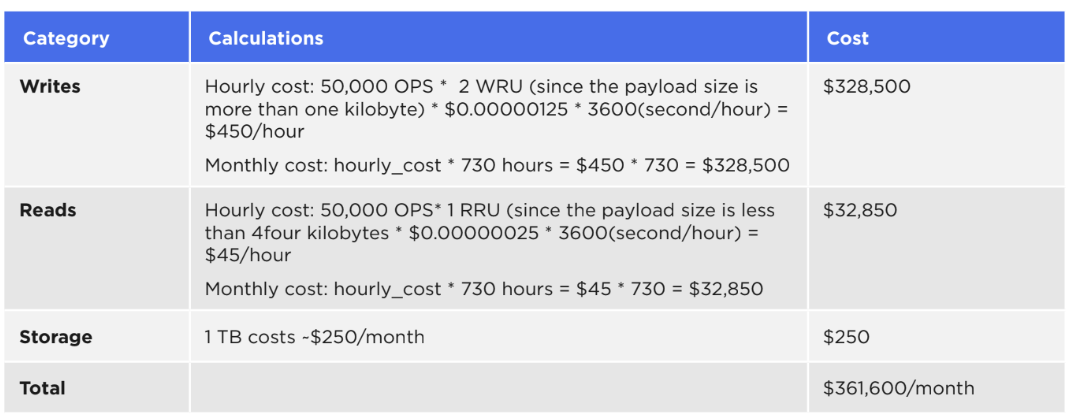
ScyllaDB Cost Calculations
As stated previously, we used ScyllaDB’s on-demand pricing for all cost comparisons in this study. ScyllaDB’s on-demand costs were determined using our online pricing calculator as follows:
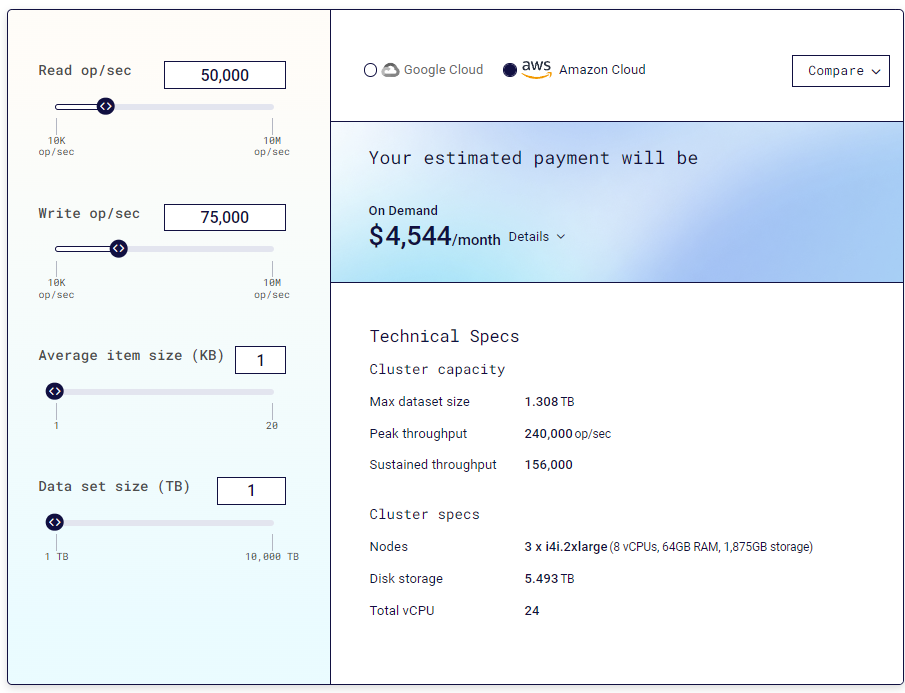
From the ScyllaDB Pricing Calculator
This calculator estimates the size and cost of a ScyllaDB Cloud cluster based on the specified technical requirements around throughput and item/data size.
Note that in ScyllaDB, the primary aspect driving costs is the cluster size, unlike DynamoDB’s model on the volume of reads and writes. Once the cluster size is determined, the deployment can often exceed throughput requirements.
For comparison, DynamoDB’s provisioned pricing structure requires users to explicitly specify sustained and peak throughput. Overprovisioning equivalent performance in DynamoDB would be significantly pricier compared to ScyllaDB.
Without an annual commitment for cost savings, the estimated annual cost for the ScyllaDB Cloud cluster is $54,528, calculated at a monthly rate of $4,544.
Conclusion
As the results indicate, what might begin at a seemingly reasonable cost can quickly escalate into “bill shock” with DynamoDB – especially at high throughputs, and particularly with write-heavy workloads. This makes DynamoDB a suboptimal choice for data-intensive applications anticipating steady or rapid growth. ScyllaDB’s significantly lower costs – a reflection of ScyllaDB taking full advantage of modern infrastructure for high throughput and low latency – make it a more cost-effective solution for data-intensive applications.
ScyllaDB – with its LSM-tree-based storage, unified caching, shard-per-core design, and advanced schedulers – allows you to maximize the advantages of modern hardware, from huge CPU chips to blazing-fast NVMe.
Beyond the presented cost savings, ScyllaDB sustains 2X peaks and provides 2X-4X better P99 latency. Additionally, it can further reduce latency when idle – or enable spare resources to be shared across multiple tables. For larger workloads spanning 500K-1M OPS and beyond, this can result in a cost saving in the millions – with better performance and fewer query limitations.
